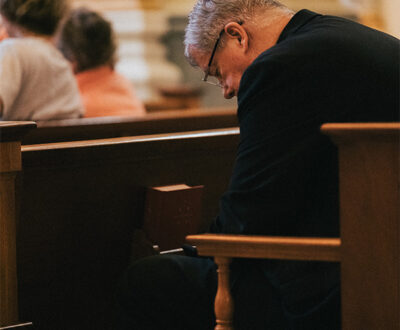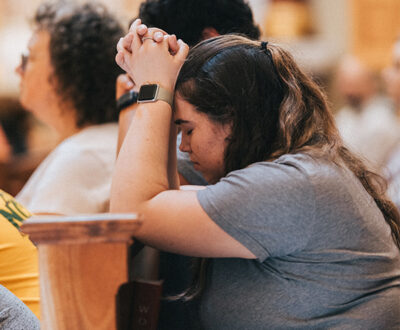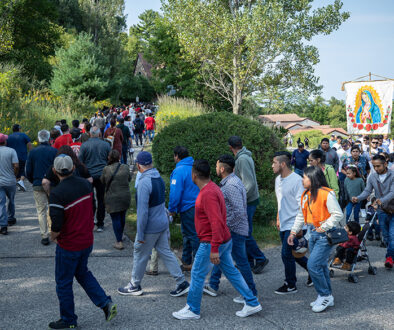Genuflecting, An Act of Adoration
Bowing and genuflecting in a Catholic church, like all liturgical rituals, are physical signs with spiritual significance. These simple gestures of reverence, related but distinct, bring body and soul together into worship of God. This is why liturgical ceremony has always been cherished at the Shrine of Our Lady of Guadalupe: because human nature, made of body and spirit, is drawn toward the spiritual world through the five senses.
Body and Soul
“Worshipping with postures is a way of uniting the work of the body and the work of the soul,” comments Fr. Ignatius Harsha, O.Praem., one of the Norbertine Fathers who serve at the Shrine. “Worship is an act proper to my soul … and yet, because the soul and the body are so closely intertwined, I need to express that through my body.” As Father goes on to explain, expressing worship through bodily gestures has a long, well-attested history, from Moses removing his sandals before the burning bush (Exodus 3:5) to the angel at Fatima instructing the children to kneel and bow their faces to the ground in prayer.
Awareness of His Presence
The difference between genuflecting and bowing, though they look similar and have related meaning, also communicates a spiritual truth. Genuflecting, literally “to bend the knee” (from the Latin words genu, knee, and flectere, to bend), is for the Presence of God. Genuflection on the right knee, in particular, has long been used to show an act of adoration, especially in earlier periods when it was customary to kneel on the left knee before bishops or kings.

Instructions for Genuflecting
The General Instruction of the Roman Missal (GIRM), §274, gives specific directions: “A genuflection, made by bending the right knee to the ground, signifies adoration, and therefore it is reserved for the Most Blessed Sacrament, as well as for the Holy Cross from the solemn adoration during the liturgical celebration on Good Friday until the beginning of the Easter Vigil.” This exception is made during Triduum, as Fr. Ignatius explains, because the Blessed Sacrament is not kept in the Tabernacle in that time.
Appropriate Times to Bow
A bow, on the other hand, is a sign of reverence but not necessarily of adoration. The faithful bow their heads in respect to holy names, including those of Jesus and Mary, and at the invocation of the Blessed Trinity. During Mass, other instances may occur. “For instance, if you’re celebrating the Mass of a saint, you bow your head at the name of the saint,” says Fr. Ignatius. Catholics also make a “profound bow” or “bow of the body” toward the altar, if the Blessed Sacrament is not present behind it. The altar deserves this honor because, as St. Ambrose says, “What is the altar of Christ if not the image of the Body of Christ?”
Fr. David Jones, of St. Benedict the African Parish in Chicago, sums up the difference well in a catechetical blog post: “We bow as a sign of respect when we recognize the symbols of the Lord. We genuflect when we recognize the Lord.”
Worship Wholeheartedly
By taking up the body into prayer, gestures of reverence can help the soul too to worship wholeheartedly. Different types of gestures show the type of honor being offered, whether adoring Our Lord’s Person or venerating something sacred to Him. Ultimately, these little rituals have the same purpose as everything at Our Lady’s Shrine and in the life of the Church: to express and foster an ever-deeper love of God.






